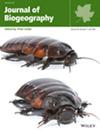Cephalopod Distribution in the Canary Current: Latitudinal and Bathymetric Patterns
Abstract
Aim
The Canary Current Large Marine Ecosystem (CCLME) is one of the four major marine upwelling systems worldwide. Cephalopods in this region exhibit high diversity and abundance, but the distributional patterns of most species are largely unknown. The present study updated the latitudinal and bathymetric distributions cephalopods species in the CCLME.
Location
Northwest Atlantic coast of Africa.
Taxon
Ninety species of Cephalopoda.
Methods
We use data from specimens collected in 10 bottom trawl surveys (2004–2012) along the coast, developed in the continental shelf and slope (20–2000 m). Only data from specimens identified to species level were considered. For bathymetric analysis data and literature widest depth range for each species were used. If our data fall outside of literature range, the depth range of the species was extended. A presence/absence matrix of species was determined to study their latitudinal distribution. In addition, species were also categorised as coastal or oceanic based on their relationship with the continental shelf and/or slope, regardless of their benthic or pelagic habits.
Results
The continental shelf is dominated by species from the Sepiidae, Loliginidae and Octopodidae. In contrast, species from the Octopodidae and Cranchiidae are predominant in slope waters. The dominant species on both the shelf and slope belonged to the families Octopodidae, Ommastrephidae and Sepiolidae. The bathymetric distribution of 13 cephalopod species was extended. The latitudinal distribution of Eledone cirrhosa, Ommastrephes cylindraceus, Ommastrephes caroli and Onykia robsoni, was extended. Clear differences in species composition were found between northern and southern of Cape Blanc.
Main Conclusions
This work provides a complete analysis of the latitudinal and bathymetric distributions of Cephalopoda species currently recorded in the CCLME, with special attention given to the differences in Cephalopoda composition between northern and southern Cape Blanc in Mauritania. No similar studies on cephalopods exist in the full area.

 求助内容:
求助内容: 应助结果提醒方式:
应助结果提醒方式:


